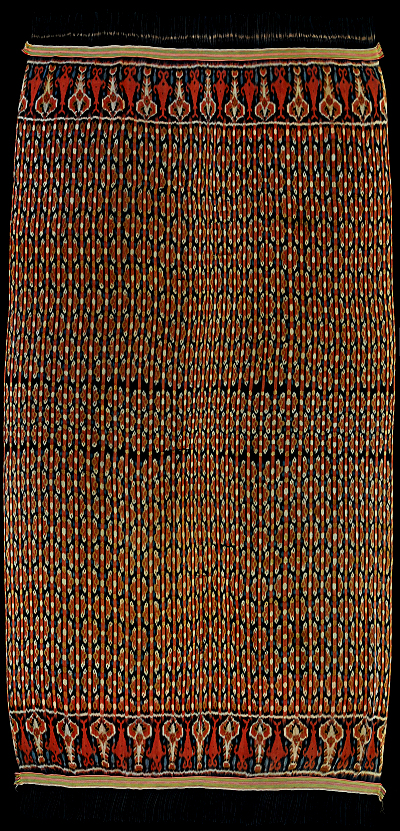| |
 
 | | | |
218 Sumba, East Sumba
Hinggi (men's blanket)  
| | Locale: | Kambera, probably. | | Period: | Early 20th c. | | Yarn: | Cotton, very fine, double-ply. Whether hand-spun or commercial could not be ascertained with confidence. See micro-photography. | | Technique: | Warp ikat | | Panels: | 2 | | Size: | 135 x 255 cm (4' 5" x 8' 4") LW: 1.89 | | Weight: | 835 g (29.5 oz), 243 g/m2 (0.80 oz/ft2) | | Design: | Rare type of patola-inspired design, not known from literature. Further research indicated. Border decorated with aquatic animals, probably lobsters and scuttlefish. Patterns such as these, that imitate the patola trade cloth that were distributed by the VOC to favoured rajas, on Sumba were always the exclusive prerogative of royalty and the nobility. The use of yellow as an additional colour is strongly indicative of royalty. | | Comment: | [PHOTOGRAPHY PROVISIONAL, SHOWING TWIN PC 219] This is a true lima varna (five colours) hinggi: the yellow kaya kuning dye was added by painting the warp threads before the weaving, a process called ndata - not, which is more common, tamped in after the weaving - as is demonstrated by the absence of lateral bleeding. Other colours are ecru, morinda red, dark indigo and pale indigo. Mid section has slightly narrower motifs, and is a fraction lighter than rest of the cloth - not a result of fading but of difference in dying. Very fine cloth of slightly below average weight. Unusual red weft. Kabakil borders and twisted fringes, ikated with a white band on one end. A few tiny holes, otherwise in immaculate condition. Remarkably, found a year after its identical twin, PC 219, though in better, near-pristine condition. From old Dutch collection. | | Background: | Chapters on Sumba and East Sumba. | | Exhibited: | Hong Kong University Museum and Art Gallery, 2017. | | Published: | HALI 192, 2017.
Ikat Textiles of the Indonesian Archipelago, 2018.
Ikat from Timor and its Outer Islands, 2022.
Noble Virtuosity: Hidden Asymmetry in Ikat from Sumba, 2024. | | Compare: | 219 193 | | Sources: | No truly similar hinggi known from literature, or museum collections on line. (Except of course its twin.) The closest comes a late 19th/early 20th C. hinggi from North Sumba (presumably Kanatang region) in Adams, Forshee, c.s., Decorative Arts of Sumba. p. 131, and a late 19th to early 20th C. hinggi from unspecified region on p. 118-119. The same patterning is found an an antique West Sumban hanggi in the Thomas Murray collection, but without the wavy pattern compression. See Aragon et al. Indonesian Textiles, Fig. 7.27. | | |

©Peter ten Hoopen, 2025
All rights reserved.
|
|


